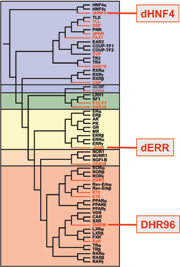1. Transcriptional regulation of metabolism by nuclear receptors
Nuclear receptors are a family of ligand-regulated transcription factors that regulate gene expression in response to binding small lipophilic compounds, such as fatty acids, sterols and bile acids. We use the fruit fly, Drosophila, as a simple model system to characterize the regulation and function of nuclear receptors with a focus on their role in metabolism. The Drosophila genome encodes 18 canonical nuclear receptors, compared to 48 in humans and 284 in C. elegans, providing the smallest complete set of nuclear receptors known in any genetic model system. In spite of this small number, the fly nuclear receptors represent all major subclasses of human receptors and include orthologs of key human receptors, providing a good model for studying nuclear receptor signaling (Figure 1). Current work is focused on three fly receptors that play central roles in metabolism: dHNF4, DHR96, and dERR.
dHNF4 - Our past studies of dHNF4 during larval stages demonstrated a role for this receptor in an essential metabolic function - the adaptive response to starvation. In this context, dHNF4 directly induces the genes that drive fatty acid oxidation for energy production, allowing the animal to survive periods of nutrient deprivation. Our current work is focused on the essential roles of dHNF4 later in development. We have discovered that dHNF4 mutant adults are sensitive to sugar in their diet. These mutants display defects similar to those we saw in our studies in larvae, demonstrating that dHNF4 is regulating lipid breakdown for energy homeostasis. In addition to this function, however, we have discovered that these animals are hyperglycemic and have reduced levels of insulin signaling in peripheral tissues. These defects are similar to those seen in human patients carrying HNF4 mutations - an early onset form of type 2 diabetes called MODY1. We are currently examining these phenotypes in more detail. To find out more, see our paper on dHNF4 in Cell Metabolism.
DHR96 - Our studies of DHR96 have revealed a central role for this receptor in lipid metabolism. In collaboration with Henry Krause's lab, we have discovered that DHR96 binds cholesterol. We have shown that cholesterol triggers a dramatic switch in gene expression, regulating key genes that control lipid uptake, trafficking, and storage. This response fails to occur in DHR96 mutants, implicating this factor as a key receptor for sterol signaling. Our current studies are aimed at defining the molecular mechanisms by which DHR96 regulates dietary lipid uptake, cholesterol trafficking, and cholesterol efflux. See our recent Genes & Development and Cell Metabolism papers to learn more.
dERR - Our studies of the Drosophila Estrogen-Related Receptor (dERR) have revealed that it directly activates a transcriptional program in embryos, coordinately inducing genes that play central roles in glycolysis, the pentose phosphate pathway, and lactate production. Combined with metabolomic analysis, this work indicated that dERR establishes a metabolic state related to the Warburg effect, which is normally associated with proliferating cancer cells. Drosophila undergo a dramatic increase in mass during larval development, leading to the model that dERR establishes a metabolic state during embryonic development that supports subsequent larval growth. This work shows, for the first time, that a proliferative metabolic program is used to support normal developmental growth. It also provides a model that clarifies our understanding of the close association between mammalian ERR family members and cancer, implicating a critical role for these receptors in promoting a metabolic state that supports growth. See our recent Cell Metabolism paper on dERR.
